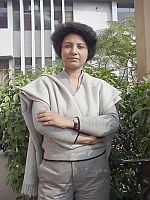Thursday, April 25, 2024
News and Views from the Global South
Q&A: Car-Centric Urban Growth Fuelled By Subsidies
Interview with Anumita Roychowdhury
- Pollution and road congestion are at crisis proportions in India’s cities. Yet, the government encourages car-centric urban growth, subsidised by public largesse, says Anumita Roychowdhury of the non-governmental Centre for Science and Environment (CSE), which is leading a campaign for cleaner air in Delhi.
Three-fourths of India’s population live in its villages. In the first two weeks of January, 35 poor cotton farmers took their lives in a region close to Mumbai, the country’s business capital, because they couldn’t return loans less than half the price of the new car.
IPS correspondent Ann Ninan spoke with Roychowdhury.
IPS: Delhi is widening roads, expanding the Metro service, and still adding new cars on the roads every day. Is that a mobility crisis?
Anumita Roychowdhury: This is mobility crisis. Increasingly, a larger share of daily travel trips are being made in personal vehicles that hog more road space, pollute more and use more energy per passenger. Even though Delhi is privileged to have more than 20 percent of its land area dedicated to roads, yet the city is gridlocked.
Delhi already has 4.5 million vehicles and is adding nearly 1000 personal vehicles a day. Cars – small as well as big, and many of them driven on toxic diesel – are jostling for limited road space. The market share of diesel cars is increasing phenomenally – already over 30 percent of new car sales, it is expected to be 50 percent by 2010. This overwhelming growth can be devastating in cities desperate for solutions to smoke, particles and nitrogen oxides (NOx). According to WHO and other international regulatory and scientific agencies, diesel particulates are carcinogens.
There is no clear blueprint to address the mobility crisis. Delhi will have to reinvent mobility framework to control numbers and usage of cars.
IPS: You have been campaigning for public transport?
AR: Let us be clear cars cannot meet the commuting needs of the urban majority. Even today public transport meets a significant share of commuting trips – 60 percent in Delhi, 80 percent in Mumbai, 70 percent in Calcutta among others. But cars and two-wheelers that occupy nearly 90 percent of the road space meet less than 20 percent of the travel demand. CSE’s assessment shows that the total number of passengers carried by all buses – public and private – each day in Delhi is approximately 8.7 million, while approximately the Metro rail transports over half a million commuters daily. This is the strength that we need to build on to move away from car centric urban growth. We need to re-design public policies to promote mobility for all … scale up efficient public transport and implement policies to restrain car use.
IPS: New low-cost cars are going to roll out of factories.
AR: This will enhance the contrasting trends in Indian market. Low cost cars are expected to expand the car ownership at the base of the market pyramid, when there is also a steady shift towards bigger and more powerful cars and SUVs in the market. Thus, both ends of the pyramid are stretched.
Cheap cars, as others, are poised to explode without stringent emission standards and adequate safety regulations. Currently, except for 11 cities, the rest of India is 10 years behind European emission standards. Eleven cities which include Delhi and Mumbai, follow Euro 3 standards.
The low cost cars will roll out much before Euro IV (Bharat IV) emissions standards are in place. Moreover, there is no system to check and guarantee on-road and lifetime emissions performance of the vehicles in India.
Even though the small cars are expected to be more fuel-efficient than big cars and SUVs, their sheer numbers will undercut the fuel savings possible from public transport.
IPS: Is air pollution under control?
AR: Pollution levels are threatening to go up again because of rapidly growing vehicle numbers. Incentives to private motorisation, through cheap cars, will have adverse impacts on air pollution, unless stringent emission standards are introduced urgently. Nearly 57 percent of cities that are monitored have critical levels of deadly particulates.
While the levels of tiny particles that go very deep into our lungs are very high in most of our cities, nitrogen dioxide levels that also aid in the formation of yet another very harmful gas ozone has also begun to rise as in Delhi. Direct exposure to traffic fumes is amongst the deadliest of the health threats. This is unacceptable.
Delhi now needs an aggressive leapfrog agenda to meet the clean air targets.
IPS: We subsidise vehicles on a gargantuan scale.
AR: Currently, public policy does not even aim to recover the full cost of owning and using a car. It in fact overtly subsidises the use of a private vehicle with public largesse. Car owners do not pay adequately for the disproportionately high usage of road space or for parking. If parking charges are adjusted to reflect the costs of providing parking in cities, the rates could be 4 to 5 times higher than the current parking rates. The government actually penalises buses by taxing them higher than cars. A 2004 World Bank study shows that the total tax burden per vehicle km is 2.3 times higher for public transport buses than cars in Indian cities. In Delhi, a bus pays roughly 43 times more road taxes than cars. But instead of addressing the policy distortion, the pressure from the vehicle industry is to reduce the taxes further to improve its affordability.

 Print
Print




